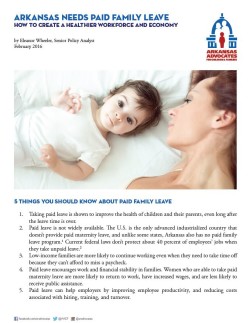
A lack of paid family leave programs in Arkansas leaves many families, particularly low-income families, in poor physical and financial health. Achieving statewide paid family leave is a great change, but a significant one. A few baby steps toward that ultimate goal could help inform a comprehensive policy that is tailored to Arkansas’s specific needs, and calm the fears that some may have about major policy change. Those first steps should start with paid maternity leave for state employees, similar to the bill proposed by Rep. Clarke Tucker in the 2015 legislative session. This would set a precedent for employers in the rest of the state and act as a quantifiable pilot program to influence future paid leave policies at a minimal cost.
Paid family leave works a lot like unemployment insurance. Employees can take time off for specific reasons, and receive either a set percentage of their wages up to a maximum level, or simply a flat rate. Paid leave can be used for a personal serious health condition, to care for a seriously ill family member, or to take care of a new child. Here are five more things you need to know about paid family leave:
1. Taking paid leave is shown to improve the health of children and their parents, even long after the leave time is over.
2. Paid leave is not widely available. The U.S. is the only advanced industrialized country that doesn’t provide paid maternity leave, and unlike some states, Arkansas also has no paid family leave program. Current federal laws don’t protect about 40 percent of employees’ jobs when they take unpaid leave.
3. Low-income families are more likely to continue working even when they need to take time off because they can’t afford to miss a paycheck.
4. Paid leave encourages work and financial stability in families. Women who are able to take paid maternity leave are more likely to return to work, have increased wages, and are less likely to receive public assistance.
5. Paid leave can help employers by improving employee productivity, and reducing costs associated with hiring, training, and turnover.
To learn more about paid leave and its impact on the workforce and the economy, download a helpful infographic here.
